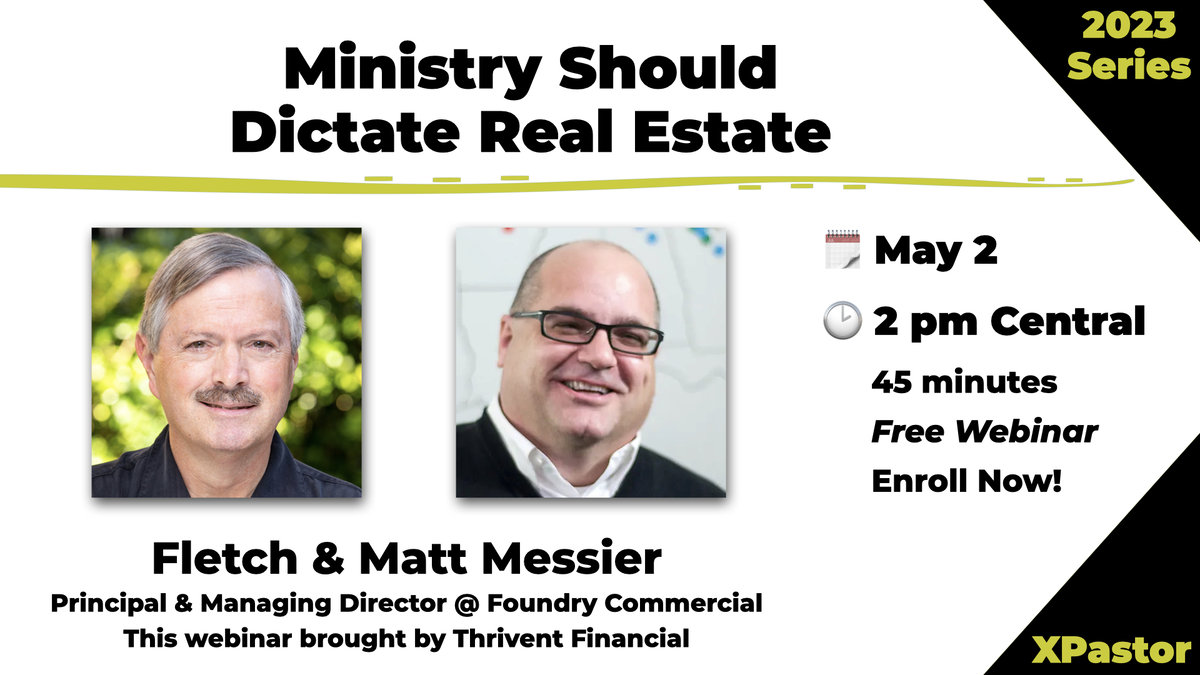In May 2006, the rented building that our 2-year-old church plant was using was no longer available to us. We were given two weeks to vacate and secure a new location, suitable for 200 people to gather and worship. Little did I realize how difficult that task would be.
The Journey Church launched its public services on Easter, 2004 in Lake Orion, Michigan—a northern suburb of the Detroit Metro area. Just prior to our launch, a local Catholic Church in Lake Orion moved into a newly constructed building, leaving their old building vacant and for sale. Though we did not think purchasing the building was an option, we did reach an agreement to rent the building at a very reasonable rate, with the understanding that the Catholic Church would continue to keep the building up for sale. For two years, we enjoyed this facility with 24/7 access.
As our new church plant grew in size, we investigated purchasing the building. The Catholic Church was asking $1.5 million for the building and six acres of property. The building itself was over 100 years old; though some of it had been renovated, there were other parts that needed major repair. We put a building team together to investigate and determine our options. After careful examination, we discovered that to purchase this building would require an additional $1 million to repair and bring it up to local codes, making the realized cost of this facility around $2.5 million.
At the same time, our building team discovered twelve acres of vacant land for sale for $260,000. The team went to work on examining this as a possibility for our new home; after careful research, we agreed this would be a better option for us to pursue. We stepped out in faith and raised over $70,000, along with $200,000 in commitments that would be given over the next three years! We celebrated our victory! We continued to rent the facility owned by the Catholic Church, hoping we might be able to stay there until we could build on our own property.
In discussions with the Catholic Church—and knowing how most commercial property transactions typically progress—we figured we’d have a three to six months warning if the property we were renting sold. We were mistaken.
A large church in the area, literally with cash in hand and without any investigation into the 100-year-old building, contacted the Catholic Church and within weeks owned the property. We were stunned at how quickly this transaction took place, but even more stunned to learn we had two weeks to vacate the building.
Challenges are not foreign to church planting or to church planters. We are a breed of people who often thrive in the midst of challenge. Upon hearing the news, I quickly rallied our team and put together a two-part strategic plan. Part One focused on moving everything we owned out of the facility within two weeks, securing storage for all our equipment (it’s amazing how much you accumulate in two years). Part Two focused on securing a long term facility to rent. I decided to personally head up the strategic focus of securing the rental facility.
My first call was to the local school district … after all, I knew many church plants were using school facilities—and successfully so. Over fifteen years ago, our mother church, Kensington Community Church, began in a high school in Troy, Michigan. Over the years, KCC has planted numerous churches around the Detroit Metro area, all using school facilities to gather in on Saturdays and Sundays. This strategy makes sense. Local schools typically do not use their buildings on Sunday mornings; in most cases the schools offer high quality, easy access facilities with generous parking. As I was dialing the phone number to the school administration office, I really thought this was going to be an easy fix to our challenge.
After a week of being passed from person to person at the school, I was finally told that the best the school could offer us was a three month lease—and they really weren’t excited about doing that much. “A three month lease?” I said to myself. “How is that going to help us?” So I dialed the number to a neighboring school district. Same response. After the third school district gave me the same response again, I realized this was not going to be the easy fix I was hoping it would be.
Frustrated, I called a few of my church planter friends to get some advice. Surprisingly, many of them were encountering the same response from their local school districts. One church, who had rented successfully from a school for three years. was given notice that their lease would end in six months! At first I thought this was just a Michigan thing. The more I talked about this with church planters in other states, I realized this is happening all over. Why? What happened to bring this change? Wouldn’t this income be a welcome bonus to most schools?
Here’s what I discovered. The high school, middle school, or elementary school facility that you want to lease in most cases will never see the money from your lease. The money goes directly into the district office. If you take away this little carrot, what incentive would any school have for leasing their building to you? Not much, actually. As a result, more and more schools are saying “no” or limiting the lease to three months, which is basically the same thing as saying “no.”
Can schools do this legally? The answer is no. Technically, we have constitutional rights to rent public buildings, as long as they allow other organizations to do so. However, what church planter wants to sue the local school in order to force them into renting their facility? That’s not the kind of publicity we really want in our community. Like it or not, the strategy of using public school facilities is losing traction in many parts of the U.S. So, with this door potentially closing to future church planting strategy, what are other options? I was about to embark on that journey.
After getting shut down by the local schools, I decided to look at commercial facilities to lease. The first thing I discovered was how expensive commercial retail property is, especially for a young church of 200 people. The going rate for commercial retail properties in shopping plazas or strip malls would cost us over $150,000 a year! Our annual church budget was only $200,000. There was no way we could afford this option. Therefore, I started looking at light industrial commercial facilities. The prices on these were more reasonable than commercial retail facilities, but parking was an issue at some locations. We did find several buildings with adequate parking; however, we were about to discover another obstacle—zoning ordinances.
It seems that in many suburbs, local zoning ordinances prohibit churches from holding public gatherings in light industrial buildings. Even if parking needs, adequate exits, and fire codes were met, the zoning still would not allow a church to gather in one of these types of facilities. And, I discovered this was not just the case in the township we were in. It was also true in five of our surrounding townships!
Fortunately, the team who led our efforts to move all our stuff out of the building we were leasing had better success. We vacated the building; since it was the end of May and the weather was nice, we decided to secure outdoor shelters at local parks to hold our Sunday gatherings. Though we were not able to rent the same shelter for the entire summer, we were able to find various outdoor shelters around town—we had a lot of fun worshipping together outdoors. Even on rainy days, people came out to worship! But as summer neared the end, I realized we had better find a long-term facility that not only had a roof, but walls and a heat source as well. Michigan winters are known to be cold! We continued looking at potential buildings and met with community zoning boards in hopes for a solution. I was running out of options.
Toward the end of August, I contacted a pastor friend in the area and asked him if they’d be open to renting their building on Saturday or Sunday nights. Moving our weekly worship gatherings from Sunday morning to Saturday or Sunday evening would be a big change, but our options were growing thinner. We gathered our church family and presented this option.
Fortunately, The Journey Church was, and still is, a resilient and determined tribe of Christ followers! Now we just had to decide between Saturday nights or Sunday nights, so I sent out a survey. When the results came in, I discovered that by choosing either Saturday or Sunday night, we’d lose about 20 percent of our attendance due to work conflicts either way.
I gathered my leadership team to make the tough decision. Most of the time, I love the thrill of leadership. This was not one of those times. In fact, I hated this decision. No matter how we chose, in essence we’d be saying to a number of friends, “You will no longer be able to worship with us.” These were people who sacrificed to help me launch and shape The Journey! I was physically ill during the days leading up to our decision.
Then someone on the team suggested alternating every other month. In other words, one month we’d gather on Saturday nights, the next month we’d gather on Sunday nights. It didn’t seem like a great plan, but it did communicate that we were going to try to be creative during the short term. So, that’s what we chose. The month of September, we’d meet on Saturday nights, and the month of October, we’d meet on Sunday nights.
By the second week in September, I realized we were in trouble. Our attendance through the summer months was dropping, and giving was down as a result. To escalate matters, attendance at our Saturday night services was about half of what our attendance was in May. This was not working, and we didn’t think the Sunday night option would be much better. Morale was beginning to slip, and our credibility as a viable long-term organization was questioned for the first time.
The hunt for an alternate facility was growing more and more frustrating. I remember driving with Ryan, our worship leader, to the “last” building in five townships. We had literally looked at every available building in five townships—well over a hundred buildings—all with the same response from local zoning committees. Ryan and I left that building and for a mile, neither of us said a word. Finally I looked over and said, “This may be the end of the road for us.” We were both tired. We decided to pray about things during the night, and then call the leadership team together the next day.
The next morning, I receive a phone call from someone on the leadership team. She said she met someone who had an empty office building who would be very interested in renting to us, and wanted to talk with us today. I was about to mention zoning, when she interrupted, “This building is in a township we haven’t approached yet. It’s a small township and they’re in the process of re-writing their zoning ordinances. We may have a chance.” I agreed to meet her at the building and meet the owner.
The location of the building was farther away than we had originally agreed to look, but I went anyway. The facility was adequate for our needs, and the owner seemed very willing to work with us. He also had some ties to the township offices, and encouraged us to apply for a building permit.
I pulled our team together to look over the facility, and had someone draw up some plans on building out the empty office space into a suitable gathering venue. Then I gathered everyone together and presented this option. Everyone knew we would not be able to sustain the church long term on Saturday or Sunday nights without major changes in our vision.
It would cost $23,000 for the build-out of the new office space, if we got approval from the township office to do so. We decided to go for it. People stepped up once again with their checkbooks. We applied for a building permit and waited anxiously for a response.
One week later, we were approved and began construction on the new space. We decided to call the local school once again and take them up on their three-month lease offer. We moved our weekly gatherings back to Sunday mornings, and built momentum toward our grand opening in the new location. Though we were excited to be moving into a stable facility, the new location was over thirty minutes from our previous location. In the months to follow, we would realize this move was like starting the church all over again in a new city.
I learned a lot from this experience. First, I learned how valuable a facility is when you’re planting a church in the suburbs. Suburban people equate a secure, pleasant facility with credibility. Second, I learned once again that planting churches is not for the weak. The challenges are high, but the rewards and the need are great. Third, I discovered that the facility challenge may become the greatest challenge in planting new churches in the suburbs. As more local schools and local zoning committees prohibit churches from gathering in obvious locations, new strategies will be necessary. Lastly, I’m reminded once again that the communities of faith that we’re piloting do not belong to us. Rather, they belong to the God of all resources and authority! In and through Him, all things are possible!











